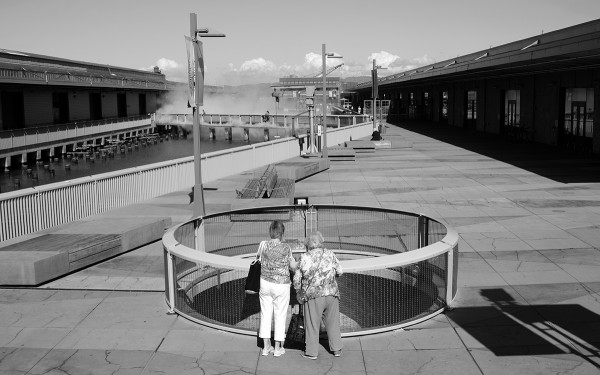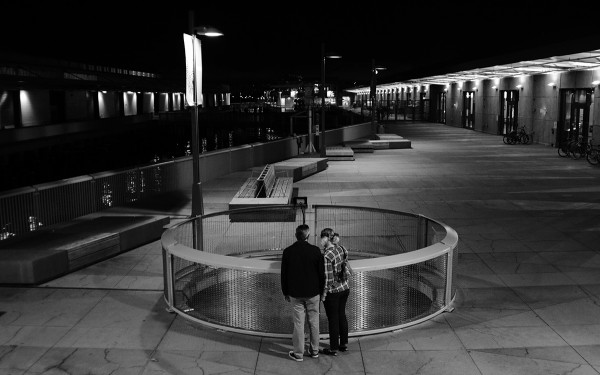Microphones inside of a hole in the pier perpetually capture sounds, playing them back through on-site speakers after a twelve-hour interval. Nothing is recorded, only delayed. An environment is shifted. An invitation to leave a message for the future: night speaks to day, day speaks to night.
All sounds were subject to the same delay, without discrimination: seagulls, trolley cars, skateboarders, church bells, school groups, office workers, tourists, families, lovers, foghorns, delivery trucks, queries, fantasies, confessions, wind, rain, screaming children; the audibly prurient thoughts that occupy people of all ages speaking into the void. Our intent was to produce two irreconcileable results: on the one hand, to render a realistic portrait of the natural and social sounds of one time overlaid onto another time (a sort of factual window for listening through to a different time at the same location), and on the other hand, to invite visitors to contemplate and engage with their own imaginary experience of this other time—to actively touch the other (as yet non-existent) time. Our project here is to examine the feedback loop produced by these twin results, not by categorizing, but by presenting their complexity verbatim.
Is the relevant learning experience to be found in focused attention on sound (both as a material and a signifying medium)? Is the exhibit’s primary purpose to play back / to present for the listener, or to offer, in the process of time-shifting, a platform for experimental performance? We propose that a relevant learning experience can be found in the creation, by speakers and listeners alike, of a common imaginary, a virtual space for contemplation external to our lived experience. I wonder where my voice went (what does it do for twelve hours?). I consider the qualities of a moment lost inside a vast duration. I switch places with the listener, bringing a message backwards from the future into the past. Why not?
Taken as a continuous document, the recorded messages present a rapid and unpredictable montage of emotional forms. Some speakers invoke complex and playful narratives consisting of interactions between multiple characters, story-lines, and time-space locations. Other speakers laugh or curse when nothing is obviously funny or upsetting, leaving an embarrassed phantom shocked at its own creepiness; uncanny for being a recording, and irresponsible for being delayed.
Why speak, if the audience can’t be verified? Paranoia interrupts, the un-knowable listener is cast as “inhuman,” albeit an inhuman that we share space with and can communicate with: “Nobody” will be there / “Nobody” was here—or “Whoever is here, I hate you,” “I will kill you,” “I hope you die,” and so on. Often this takes gentler forms, as interspecies communication (whale song, “Sharks come out!”, “Hello, fishies!” etc.), or command utterances seeking a cure for disarray: “Go to work!”, “Go Home!”, “Get a job!”, “Go to sleep!”, “I hope to be at home safe.” For a group encountering the piece all at once, the mania of showing off, along with a tendency towards imitation, results in funny looping stutters, as variations on the roles of teacher, student, reporter, monster, victim, etc. are worked out.
How do we rationally understand a time scale or duration outside of what we are able to sense? Every interaction is also a test of the channel’s openness, a question uselessly waiting for an answer to travel across an interval that, while not impossible, is improbable for anyone finding themselves at the installation site to directly experience. Leaving a message as a ‘proof’ or ‘truth’ of a proposition that is un-testable (un-thinkable?) in the present moment engages a need very close to our own desire to collect and convey these messages, first through the mechanism itself, and now through these eavesdropped transcriptions. In the act of composing messages for future listeners, each speaker has given a unique form to the sensation of holding one’s attention in two times at once. As artists-in-residence transiently interacting with communities of practice, our research is presented beside the work of explanation and inquiry carried out by visitors and staff every day. In the usage described by Eve Kosofsky Sedgwick: “Beside comprises a wide range of desiring, identifying, representing, repelling, paralleling, differentiating, rivaling, leaning, twisting, mimicking, withdrawing, attracting, aggressing, warping, and other relations.” As artistic research, this project is not to essentialize, nor to act as role-model or interrogator, but primarily to listen, and to provide forms that are able to preserve contradiction.

